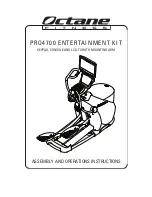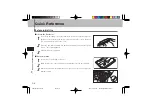
RIBBON CONTROLLER | 15
PERFORMANCE CONTROLS
Octave (Transpose) Up/Down
These buttons should be self explanatory. They change
the range of the keyboard, but must be pressed before you
play to get the transposed values. They will not transpose
keys currently held.
Unison
Activates Unison mode, which is configured in the Home
menu, page 4.
Seq On
Activates the Sequencer, which is configured in the four
sequencer tabs (SeqA, SeqB, SeqC, and SeqD) on the
graphic display.
Arp On
Activates the Arpeggiator, which is configured on the Arp
tab on the graphic display.
Hold
Has the function of a sustain switch. It does not work with
the sequencer, as this is a ‘gated’ sequencer, which only
works when keys are held down. This control can be used
to “latch” the arpeggiator on.
Tempo
This button is actually a Tap Tempo button as well. Holding
it down will allow a pop-up on the screen to show the cur-
rent BPM, and allow you to change it with either left most
knob of the Graphic Display. Tapping the Tempo button will
determine an average BPM after 2 taps, and will continue
to average the tempo for subsequent taps. Tempo is stored
with the preset, but can be overridden (ignored) by setting
this in the System page. Select ‘Load BPM - ON’ if you
want the presets to load their programmed tempos.
Enable Part Buttons
Figure 15.
Enable Part
Enable Part Buttons
These buttons allow you to disable, or mute, the signal
coming from each of the four mixers. A lit LED above any of
the buttons means that mixer’s output will be heard. Enable
Part settings are stored with presets.
A number of Solaris’s presets have been pro-
grammed to take advantage of the Enable Part
buttons to alter the preset in a desirable way. When
creating your own presets, experiment with using
the Enable Part buttons to allow you to alter your
sounds on the fly, without having to select a differ
-
ent preset.
Assignable Performance Knobs
Even though you have five text screens to edit parameters,
doing so will immediately take you out of Preset Mode.
Also, there are parameters in the graphic display for many
different functional groups, and you might want to have ac-
cess to these. To give you quick access to any parameter in
the system, the bottom five knobs below the graphic display
can be assigned. You use the
Shift
button (to the left side
of the lower row of knobs) to assign these knobs.
Figure 16. Performance Knob Assignment
1. Holding down the
Shift
button, select which of the 5
Performance Knobs you want to assign by giving it a
turn.
2. Continue to hold down
Shift
, and select the parameter
you wish to associate with the Performance Knob.
3. Release the
Shift
button. You should see a descriptive
text string for the assigned knob at the bottom of the
screen.
As shown in Figure 16, you will also see a +/- % value. The
Performance Knobs are relative to the programmed value.
They can add or subtract from the parameter value. Only
a one-to-one assignment is allowed (one parameter per
knob). Since the parameters in the text displays are fairly
easy to reach, usually these Performance Knobs will be
selected from one of the many soft key pages, but they can
be any stored Preset parameter you want, to provide quick
access, and keep the synth in Preset Mode. Performance
Knob assignments are stored with presets.
Pitch and Modulation Wheels
These function as you might expect. The range of the pitch
wheel--both up and down--can be set independently using
the parameters
PW Up
and
PW Down
in the Home sec-
tion, page 3. Note that since these parameters are bipolar,
the pitch ranges for up and down movement can be inde-
pendently adjusted and reversed.
Joystick
The
Joystick
is a springless controller designed to be used
with vector synthesis types of sounds. Its X and Y position
are available in most modulation source lists, so it can be
used as a real-time controller for most of Solaris’s param-
eters.
Ribbon Controller
The
Ribbon Controller
outputs 2 separate control signals.
If you use a single finger, the output signal for
Rib1
and
Rib2
are the same. If you use two fingers, the control signal
associated with the right most finger is output as
Rib2
.
Summary of Contents for Solaris
Page 1: ...User Guide Version 1 ...
















































